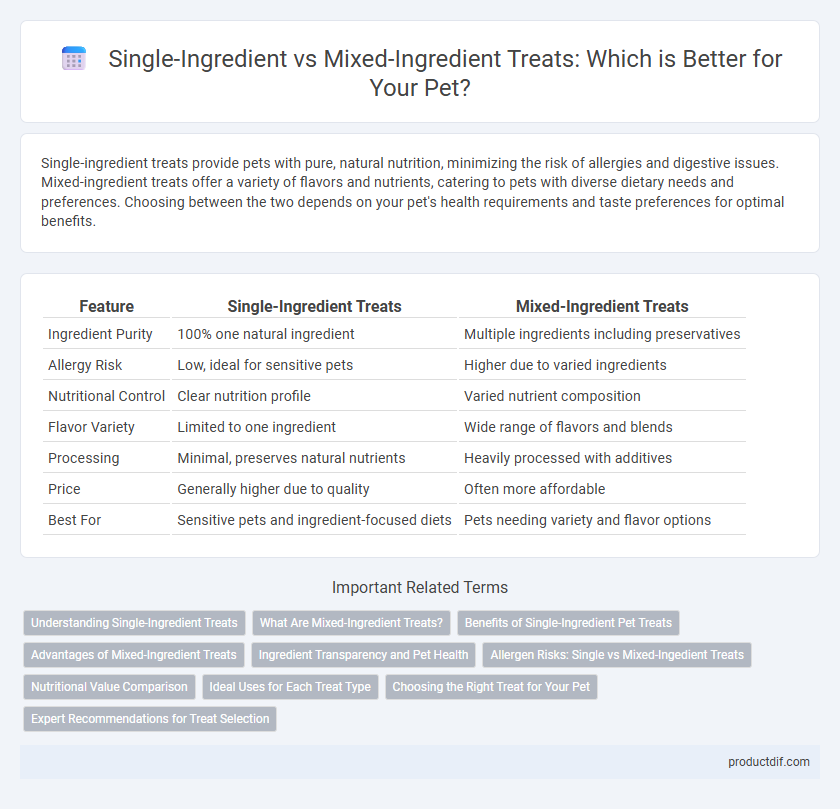Single-ingredient treats provide pets with pure, natural nutrition, minimizing the risk of allergies and digestive issues. Mixed-ingredient treats offer a variety of flavors and nutrients, catering to pets with diverse dietary needs and preferences. Choosing between the two depends on your pet's health requirements and taste preferences for optimal benefits.
Table of Comparison
| Feature | Single-Ingredient Treats | Mixed-Ingredient Treats |
|---|---|---|
| Ingredient Purity | 100% one natural ingredient | Multiple ingredients including preservatives |
| Allergy Risk | Low, ideal for sensitive pets | Higher due to varied ingredients |
| Nutritional Control | Clear nutrition profile | Varied nutrient composition |
| Flavor Variety | Limited to one ingredient | Wide range of flavors and blends |
| Processing | Minimal, preserves natural nutrients | Heavily processed with additives |
| Price | Generally higher due to quality | Often more affordable |
| Best For | Sensitive pets and ingredient-focused diets | Pets needing variety and flavor options |
Understanding Single-Ingredient Treats
Single-ingredient treats for pets consist solely of one natural component, such as dehydrated chicken, sweet potato, or salmon, offering a highly digestible and hypoallergenic option ideal for pets with dietary sensitivities. These treats provide clear nutritional benefits by eliminating fillers, preservatives, and artificial additives commonly found in mixed-ingredient products. Pet owners seeking to maintain a clean and focused diet often prefer single-ingredient treats to ensure transparency and quality in their pet's nutrition.
What Are Mixed-Ingredient Treats?
Mixed-ingredient treats combine various components such as proteins, grains, fruits, and vegetables to provide balanced nutrition and diverse flavors for pets. These treats often include ingredients like chicken, sweet potatoes, and blueberries, delivering essential vitamins, minerals, and antioxidants in one convenient snack. Mixed-ingredient treats support overall pet health by offering a variety of nutrients that cater to different dietary needs and preferences.
Benefits of Single-Ingredient Pet Treats
Single-ingredient pet treats offer superior nutritional transparency, allowing pet owners to avoid allergens and additives commonly found in mixed-ingredient options. These treats typically provide higher concentrations of essential nutrients, such as protein or omega fatty acids, directly benefiting pet health and digestion. Their simplicity also reduces the risk of adverse reactions and supports dietary management for pets with sensitivities or special health needs.
Advantages of Mixed-Ingredient Treats
Mixed-ingredient treats offer pets a balanced combination of nutrients from various sources, enhancing overall health and variety in flavor profiles. These treats often include vitamins, minerals, and antioxidants that single-ingredient options might lack, supporting immune function and digestion. The diverse texture and taste also help maintain pet interest and provide a more enjoyable snacking experience.
Ingredient Transparency and Pet Health
Single-ingredient treats offer clear ingredient transparency, helping pet owners avoid allergens and monitor nutrient intake precisely. Mixed-ingredient treats may contain fillers or additives that obscure ingredient quality and potentially impact pet health negatively. Prioritizing single-ingredient options supports better digestion and reduces the risk of adverse reactions, ensuring optimal pet wellness.
Allergen Risks: Single vs Mixed-Ingedient Treats
Single-ingredient pet treats significantly reduce allergen risks by containing only one protein or carbohydrate source, making them ideal for pets with food sensitivities or allergies. Mixed-ingredient treats often include multiple protein sources and additives, increasing the likelihood of an allergic reaction in sensitive pets. Choosing single-ingredient options helps pet owners better control dietary factors and minimize exposure to potential allergens.
Nutritional Value Comparison
Single-ingredient treats, such as dehydrated chicken or freeze-dried liver, deliver high concentrations of pure protein, vitamins, and minerals with minimal processing, preserving natural nutrients. Mixed-ingredient treats often contain fillers, preservatives, and additives that can dilute nutritional quality and introduce unnecessary carbohydrates or artificial flavors. Choosing single-ingredient treats supports a more natural diet, promoting better digestion, fewer allergies, and enhanced overall pet health.
Ideal Uses for Each Treat Type
Single-ingredient treats, such as dehydrated chicken or freeze-dried liver, are ideal for pets with food sensitivities or allergies, providing a pure source of protein without additives. Mixed-ingredient treats, combining proteins, grains, and vegetables, offer balanced nutrition and are perfect for rewarding pets during extended training sessions. Choosing the right treat type depends on the pet's dietary needs and the specific training or reward goals.
Choosing the Right Treat for Your Pet
Single-ingredient treats, such as dehydrated chicken or sweet potato slices, provide pets with natural, easily digestible nutrition free from unnecessary additives or fillers that often cause allergies or digestive issues. Mixed-ingredient treats offer a combination of proteins, grains, and vitamins designed to address specific dietary needs or support overall health but may contain preservatives or artificial flavors. Selecting the right treat depends on your pet's dietary sensitivities, health goals, and ingredient transparency to ensure optimal nutrition and enjoyment.
Expert Recommendations for Treat Selection
Veterinarians and pet nutritionists emphasize the benefits of single-ingredient treats for pets with allergies or sensitive stomachs due to their simplicity and transparency in ingredients. Mixed-ingredient treats offer balanced nutrition and a variety of flavors but should be selected with attention to ingredient quality and avoid artificial additives. Expert recommendations prioritize treats with natural, non-GMO components and minimal preservatives to promote optimal pet health.
Single-Ingredient Treats vs Mixed-Ingredient Treats Infographic

 productdif.com
productdif.com